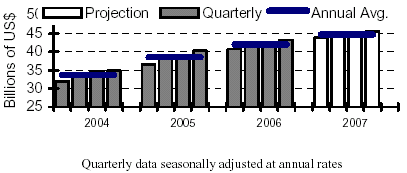|
US office furniture braces for lower growth
This second article of a four part series covers trends in the American office furniture market.
The most important stimulus for American office furniture stems from corporate profits. Growth of pre-tax corporate profits in
the US in 2006 stood at 21.4%. This is a very satisfactory rate and up from 12.5% the year before. Due to theslowdown of the US economy, corporate profit growth in
2007 and 2008 will be much lower, anticipated to be less than 5%. On the positive side,
the weakness of the American dollar provides some stimulus to export oriented
corporations.

Business investments progressed at a rate of 7.2% in 2006.
The anticipated decline in corporate profitability in 2007 will cause a significantly lower growth rate of corporate
investments, approximately at 3.4%. This may have a negative impact on office furniture consumption.
Indeed, investments in machines & equipment ¨C which includes office furniture ¨C is already on a downward trend. After
advances of 6.5% last year, the performance this year will probably lie between 2% to 3%.
In addition to private sector investments, government spending is providing support to the
economy in general and the office furniture industry in particular. Government
investments remained in the positive realm in the last few years, growing by about 2% per annum up to 2006 except
for a temporary dip ¨C down to 0.9% ¨C in 2005. However, due to the high US budget
deficit, government spending is bound to slow down. Growth will most likely remain
below the 2% mark in the foreseeable future.
Coinciding with the good corporate profitability during the past few years, the job market
improved as well. As corporations stepped-up the hiring of workers, employment growth stood at 1.9% last year. However,
wage rates are likely to rise and sagging corporate profits will damper further job creation. For this year and next,
we estimate an advance of only 1.3% which translates to approximately 1.7 million new work places each year.
Expenditures on non-residential construction, including office space, were frail up to 2005,
growing around 1% to 2%. A significant improvement was observed last year. In
fact, non-residential construction value grew by a healthy 8.9%. Indications so far suggest that the
investment activity will be slower again this year, and drop steeply to only about 3.8% in 2008.
Nevertheless, the current supply of available office space is still sufficient to accommodate
any expansion of office employment in the near future.
Following several years of decline, positive growth of businesses¡¯ outlays for office furniture
resumed in 2003. However, progress remained very slow and did not reflect the overall upward
trend in business investments. The office furniture market advanced by 14.3% in 2005,
reaching $ 38.5 billion (end-user prices and including recycled furniture), surpassing the previous peak
value in 2000. Growth in 2006 stood at 9.0%, bringing the market size for the first time to a value in excess of $ 40 billion.With lower corporate profits, slower employment growth
and much of the backlog of demand for office furniture satisfied, we predict for growth in the office furniture
market will slow about 4.6% in 2007.

|